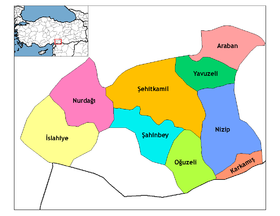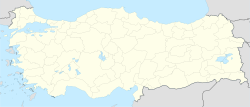كركميش
كركميش Karkamış، وتُكتب أيضاً كرگميش Kargamış (كردي: Girgamêş)، هي بلدة وقضاء في محافظة غازيعنتپ في جنوب شرق تركيا، بجوار موقع Karkemish. وكان تعداد البلدة 2,998 نسمة في 2010.
كركميش
Karkamış | |
|---|---|
 موقع كركميش في جنوب شرق محافظة غازيعنتپ، بجنوب شرق تركيا | |
| الإحداثيات: 36°50′02.40″N 38°00′03.60″E / 36.8340000°N 38.0010000°ECoordinates: 36°50′02.40″N 38°00′03.60″E / 36.8340000°N 38.0010000°E | |
| البلد | |
| المنطقة | جنوب شرق الأناضول |
| المحافظة | غازيعنتپ |
| الحكومة | |
| • العمدة | علي دوغان (CHP) |
| المساحة | |
| • القضاء | 309٫89 كم² (119٫65 ميل²) |
| التعداد (2012)[2] | |
| • Urban | 3٬034 |
| • District | 10٬587 |
| • كثافة District | 34/km2 (88/sq mi) |
| منطقة التوقيت | UTC+2 (EET) |
| • الصيف (التوقيت الصيفي) | UTC+3 (EEST) |
| Postal code | 27xxx |
| مفتاح الهاتف | +(90)342 |
| الموقع الإلكتروني | [3] |
وهي معبر حدودي على الطريق إلى جرابلس في سوريا. وفي 2004, 8,071 vehicles and 38,263 people passed the border checkpoint into Turkey while 8,795 vehicles and 35,474 people crossed it towards Syria.[4]
The River Euphrates runs east of Karkamış southwards into Syria. At this place, a railway bridge of 870 m (2,850 ft) that was built between 1911-1913 by German engineers as part of the Istanbul-Baghdad Railway, crosses the river parallel to the border line.[5]
One of the 21 dams of the Southeastern Anatolia Project (GAP), the Karkamış Dam and hydroelectric power station is located 4.5 km (2.8 mi) upstream from the border crossing of Euphrates.[6]
In March 2011, the Turkish military base which included Karkemish ruins was cleared of mines. Archaeologists from Italy and Turkey began excavations in the town in September 2011.[7]
. . . . . . . . . . . . . . . . . . . . . . . . . . . . . . . . . . . . . . . . . . . . . . . . . . . . . . . . . . . . . . . . . . . . . . . . . . . . . . . . . . . . . . . . . . . . . . . . . . . . . . . . . . . . . . . . . . . . . . . . . . . . . . . . . . . . . . . . . . . . . . . . . . . . . . . . . . . . . . . . . . . . . . . .
التاريخ
The Municipality of Karkamış was established in 1961 (in fact it was called Barak at that time), before then having been assigned administratively under Nizip. At the time of the famous British Museum excavations at the nearby archaeological site lying to the East (1911–1914, 1920), Karkamış did not yet exist, only the railway station built by the Germans was already there, since the main village at that time was Jarabulus, now in Syria. After the Turkish War of Independence, a settlement was established around the railway station which came to be named after the famous nearby archaeological site.
التراث الأثري
الموقع القديم لكركميش هو الآن موقع هائل من الأطلال، يقع على الضفة الغربية لنهر الفرات، على بعد نحو 60 كم جنوب شرق عنتاب، تركيا و 100 كم شمال شرق حلب، سوريا. The site is crossed by the Turco-Syrian border. A Turkish military base has been built after 1920 on the Karkemish acropolis and Inner Town, and access to the acropolis is still restricted. Most of the Outer Town lies in Syrian territory.
Karkemish has always been well known to scholars because of several references to it in the Bible (Jer. 46:2; 2 Chr. 35:20; Isa. 10:9) and in Egyptian and Assyrian texts. However, its location was identified only in 1876 by George Smith.
The site was excavated by the British Museum, 1878-1881 by Patrick Henderson, 1911 by D. G. Hogarth and R. C. Thompson, and from 1912 to 1914 by C. L. Woolley, and T. E. Lawrence ("Lawrence of Arabia").[8][9][10] Excavations were interrupted in 1914 by World War I, resumed in 1920 with Woolley and then ended with the Turkish War of Independence.[11] These expeditions uncovered substantial remains of the Neo-Hittite and Neo-Assyrian periods, including defensive structures, temples, palaces, and numerous basalt statues and reliefs with Luwian hieroglyphic inscriptions.
Following the completion in March 2011 of mine clearing operations on the Turkish portion of the site, archaeological work was resumed in September 2011 by a Turco-Italian joint archaeological expedition under the direction of Prof. Nicolò Marchetti of the University of Bologna.[12] In July 2019 an archaeological park has been opened at the site.
انظر أيضاً
- Carchemish for a fuller archaeological description
المراجع
- ^ "Area of regions (including lakes), km²". Regional Statistics Database. Turkish Statistical Institute. 2002. Retrieved 2013-03-05.
- ^ "Population of province/district centers and towns/villages by districts - 2012". Address Based Population Registration System (ABPRS) Database. Turkish Statistical Institute. Retrieved 2013-02-27.
- ^ "[Yerelnet] Kargamiş İlçesi" (in التركية). Yerelnet.org.tr. Retrieved 2012-10-30.
- ^ "İdari Durum" (in Turkish). Karkamış Kaymakamlığı. Retrieved March 15, 2009.
{{cite web}}: CS1 maint: unrecognized language (link) - ^ "Tarihi Fırat Demiryolu Köprüsü" (in Turkish). Karkamış Kaymakamlığı. Retrieved March 15, 2009.
{{cite web}}: CS1 maint: unrecognized language (link) - ^ "Karkamış Barajı" (in Turkish). Karkamış Kaymakamlığı. Retrieved March 15, 2009.
{{cite web}}: CS1 maint: unrecognized language (link) - ^ "Ancient city to rise in SE Turkey area cleared of mines". Hurriyetdailynews.com. Retrieved 2012-10-30.
- ^ D.G. Hogarth, Carchemish I: Introductory, The British Museum Press, 1914, repr. 1969
- ^ C.L. Woolley, Carchemish II: Town Defences: Report on the Excavations at Jerablus on Behalf of the British Museum, British Museum Press, 1921, repr. 1969, ISBN 0-7141-1002-7
- ^ C.L. Woolley & R.D. Barnett, Carchemish III: Excavations in the Inner Town: Report on the Excavations at Jerablus on Behalf of the British Museum, British Museum Press, 1952, repr. 1978, ISBN 0-7141-1003-5
- ^ H. G. Güterbock, "Carchemish", Journal of Near Eastern Studies, vol. 13, no. 2, pp. 102–114, 1954
- ^ "Mine-clearing work in Karkamış nears completion". Todayszaman.com. 2010-12-05. Retrieved 2012-10-30.
